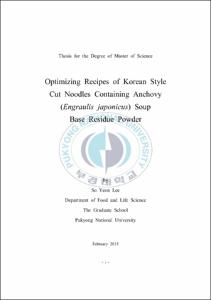Optimizing Recipes of Korean Style Cut Noodles Containing Anchovy
- Abstract
- 단백질과 칼슘함량이 높은 칼국수를 개발하기 위하여 훈련된 관능요원들의 관능평가를 바탕으로 한 반응표면분석법으로 멸치잔사분말, 밀가루 및 물의 최적배합비율을 알아보고자 하였다. 멸치 잔사 분말을 첨가한 칼국수(CNAR)의 조직감과 영양학적 평가를 실시하였는데, 감칠맛과 쫄깃함이 높고, 비린맛이 낮을수록 전반적인 기호도가 높게 평가되었다. CNAR의 최적 배합비율은 밀가루 96.02 g, 멸치 잔사 분말 2.67 g, 물 50.64 mL로 계산되였다. CNAR의 검성과 부착성은 유의적으로 낮았으나(P<0.001) 쫄깃함, 경도, 응집성은 일반 칼국수(control)에 비해 유의적으로 높았으며(P<0.001), 씹힘성 역시 유의적으로 높게 나타났다(P<0.05).
멸치 잔사의 첨가로 인해 조단백질, 조지방, 조회분함량은 control에 비해 CNAR에서 높게 나타났다. 색도는 멸치 잔사 분말이 첨가된 CNAR에서 L, a, b 값 모두 감소하였다. In vitro 단백질과 전분 소화율에 있어서 CNAR은 control보다 낮게 나타났다(P<0.01). CNAR의 유리아미노산 총량은 control보다 유의적으로 높게 나타났으며(P<0.01), 이에 따라 CNAR의 감칠맛이 더 높게 나타난 것으로 나타났다. 건조한 멸치 잔사 분말 가루를 칼국수 반죽에 첨가하여 영양적, 관능적 기호도를 증가시키며 경제적으로 이익을 줄 수 있는 것으로 생각되었다.
- Issued Date
- 2015
- Awarded Date
- 2015. 2
- Type
- Dissertation
- Publisher
- 부경대학교
- Affiliation
- 부경대학교
- Department
- 대학원 식품생명과학과
- Advisor
- 류홍수
- Table Of Contents
- Contents
Table of Contentsⅰ
Lists of Tables ⅳ
Lists of Figuresⅴ
Abstracts ⅷ
Ⅰ. Introduction 1
Ⅱ. Materials and Method 4
1. Sample preparation 4
1.1. Materials 4
1.2. Preparation of Korean style cut noodles 4
2. Response surface methodology (RSM) 5
2.1. Central composition design for RSM 5
2.2. Sensory evaluation 9
3. Nutritional quality evaluation 10
3.1. Proximate composition 10
3.2. Free amino acid 10
3.3. In vitro protein digestibility 11
3.4. Trypsin indigestible substrate (TIS) 12
3.5. Amino acid analysis 12
3.6. Computed protein efficiency ratio (C-PER) 13
3.7. In vitro starch digestibility 13
4. Texture analysis 13
5. Color 14
6. Statistical analysis 14
Ⅲ. Result and Discussion 17
1. Sensory evaluation 17
1.1. Sensory attributes 17
1.1.1. Darkness 17
1.1.2. Fishy smell 21
1.1.3. Pleasant smell 23
1.1.4. Fishy taste 23
1.1.5. Palatability 25
1.1.6. Springiness 28
1.1.7. Grittyness 30
1.1.8. Overall acceptability 30
1.2. Optimal values 32
2. Nutritional quality 34
2.1. Proximate composition 34
2.2. Free amino acid 37
2.3. In vitro protein digestibility 37
2.4. Trypsin indigestible substrates (TIS) 40
2.5. Computed protein efficiency ratio (C-PER) 41
2.6. In vitro starch digestibility 41
3. Textural analysis 43
4. Color 45
Ⅳ. Conclusion 47
Ⅴ. References 48
- Degree
- Master
- Files in This Item:
-
-
Download
 Optimizing Recipes of Korean Style Cut Noodles Containing Anchovy.pdf
기타 데이터 / 1.27 MB / Adobe PDF
Optimizing Recipes of Korean Style Cut Noodles Containing Anchovy.pdf
기타 데이터 / 1.27 MB / Adobe PDF
-
Items in Repository are protected by copyright, with all rights reserved, unless otherwise indicated.